| T O P I C R E V I E W |
| James N. |
Posted - January 06 2012 : 11:50:12 AM
The recent posts here about the discovery of the site of Fort Hunter motovated me to "revisit" photos taken in the Mohawk Valley in the fall of 1993 on one of my "flying vacations" to Upstate New York. I was then studying the Revolution in those areas, particularly as it involved the family of Sir William Johnson, his "brother-in-law" Joseph Brant, and patriot Col. Marinus Willett. Having previously visited Saratoga, I wanted especially to see those places in the valley relating to Burgoyne's campaign, mainly Ft. Stanwix and Oriskany Battlefield.
Image Insert:
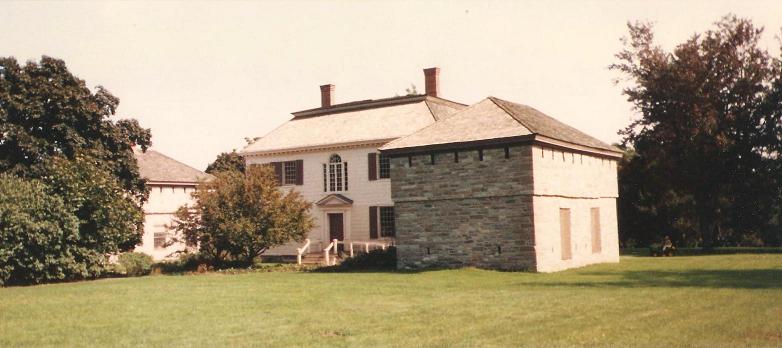
47.52KB
Johnson Hall, now a part of the New York State Park system. The spacious lawn served as the scene of many conferences with Johnson's allies the Iroquois.
Sir William Johnson is probably the most remarkable personality produced by Colonial America, rivaled only by George Washington. A "Scots-Irish" native of Ireland, he came to the Mohawk Valley as a young man in his twenties to administer lands granted to his uncle for victories against France in the naval wars of the 1740's. He soon gained a reputation among his neighbors, the Mohawks as a fair trading partner truly interested in them and their culture. ( A somewhat more "civilized" version of Hawkeye! ) The valley was being settled by Palatinate Germans, tenants on the lands Johnson administered, and he married one of these girls named Catherine, fathering three children. Upon her death, he "married" in Indian ceremony Molly Brant, elder sister of later Chief Joseph Brant, whom he sponsored and sent to mission school to educate. With Molly and another Indian "wife" he sired another eleven children!
We remember him here as a leader in the French and Indian War, rallying the Mohawk and other Iroquois to support the British cause. As commander of one wing of the British advance in 1755, he defeated the French on the shores of Lac Ste. Sacrament, which he promptly renamed Lake George, selecting its southern shore as the location of a fort he named William Henry! Later, through an accident which decapitated the British general in command of besieging forces, Johnson as second-in-command accepted the surrender of French Fort Niagra. Though an "ameteur" soldier, he emerged from the war as a genuine hero and was knighted for his service to the crown, becoming known somewhat disparagingly ( and enviously! ) as "The Mohawk Baronet".
No less than three of his homes survive in the valley near Johnstown, named for him, and where he was buried following his death in 1774 following a long illness resulting from complications of the wound he had recieved at the Battle of Lake George nearly twenty years earlier. Tended faithfully by his Lady of the Mohawks, he fortunately died prior to seeing the Revolution wipe out much that he had accomplished, impoverishing and making refugees of his legitimate heirs and his reputedly many half-blood offspring, both from his liason with Molly and others.
Image Insert:
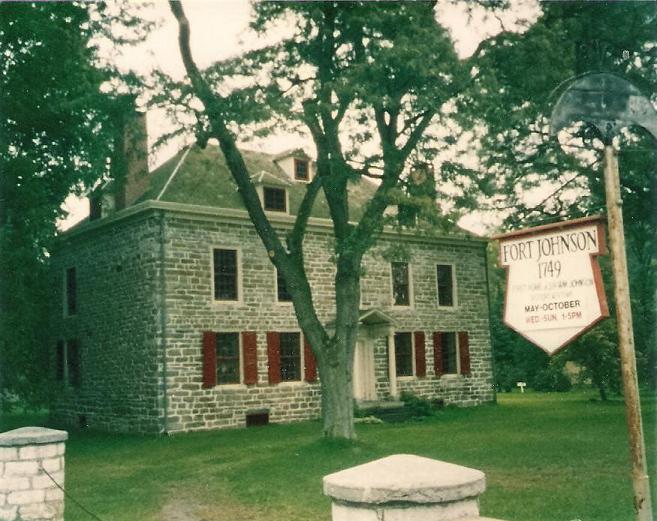
74.71KB
Image Insert:
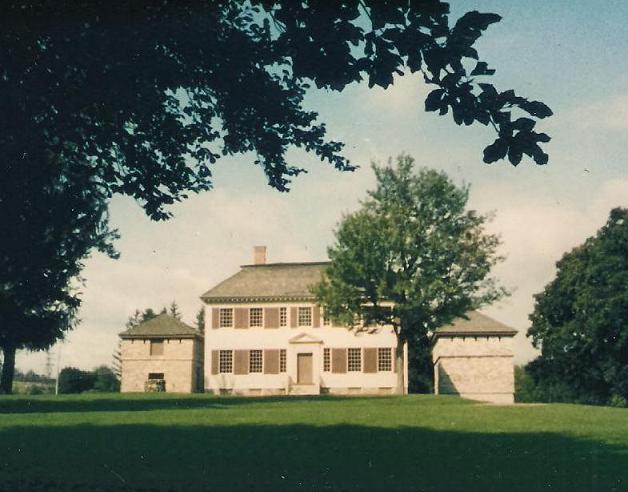
52.58KB
The 1749 stone house above was a typical frontier "forted" house, substantially built, with loopholes for firing muskets. Johnson Hall was built about 1762 when he thought the threat of war was likely over, and is of wood construction, similar to its contemporary Mount Vernon. Johnson died in one of the downstairs rooms, converted into his bedchamber when he could no longer climb the stairs. The blockhouse on the left is one of two originals ( the other is a replica ), which served mainly for storage despite their military appearance. |
| 17 L A T E S T R E P L I E S (Newest First) |
| Wilderness Woman |
Posted - January 14 2012 : 2:07:38 PM
My groups don't attend Bushy Run, so I doubt we will be there next year.
The Augusta Regiment has a website: www.augustaregt.org
The Weiser Battalion doesn't have one. |
| Dave T |
Posted - January 13 2012 : 11:17:28 PM
WW, do your respective regiments have websites (I assume they do). What might those addresses be so I can check them out. . .
While I took in the F & I 250th events in New York as a tourist between '05 - '10, I'd love to participate in a 250th event as a reenactor....
I bet your thinking the same thing I am (!) . . . the last 'big' 250 event is the Battle of Bushy Run next year (though the folks at Fort Michilimackinac do have a baaga`adowe tourney next year too). . . .
So, need any additional hands in your regiments come next year??? :D |
| Wilderness Woman |
Posted - January 11 2012 : 12:50:59 PM
Dave,
I am a member of two F&I groups. My primary unit is the 3rd Battalion Pennsylvania -- aka The Augusta Regiment, based out of Sunbury, PA. Mike Slease (Seamus on this board) is the Captain. My secondary unit is a "brother" regiment -- the 1st Battalion Pennsylvania -- Conrad Weiser's Regiment. Lynn Otto is the Captain. Although most of our re-enacting events are in Pennsylvania, we have been at the now-defunct F&I event at Fort Ticonderoga/Carillon many times, the Fort Niagara 250th, and Johnson Hall Market Fair in New York.
I actually live in Binghamton, NY, and am also a member of the Chemung Valley Living History group that puts on the annual Battle of Newtown at Newtown Battlefield State Park near Elmira each August. |
| Dave T |
Posted - January 10 2012 : 11:44:13 PM
Hello WW!!
As for what group(s) I reenact with, thanks for asking. The two F & I units are:
1) Capt. Thomas Terry's New York Provincial Company
2) Col. Jonathan Bagley's 3rd Massachusetts Provincial Regiment
From these two I have networked into two Rev War units:
5th New York Regiment
13th Albany County Militia, 4th Company
I've also gotten War of 1812 invites for this year too . . . so many events, so little time.
I tell my friends New York has NO shortage of wars or forts!! Or great people - that goes for fellow reenactors and colonial era heroes and heroines.
You do any reenacting in NY or elsewhere? I know I've missed a few Mohicanites in NY over the years. . . (save for Fitzhugh W.)
Hello James, and thanks for the info on Tim Murphy. . . I might have figured there was a 'rest of the story!'
Your postings, especially from last year, (and Lane Batot's more recent for that matter) have been wonderfully informative. Thanks very much. |
| James N. |
Posted - January 08 2012 : 10:52:49 AM
quote:
Originally posted by Dave T
I couldn't get near the Murphy rifle (whether it is 'the' rifle that took out Fraser is not definitely known) they have on display. . .
Hi Dave - welcome to the Forum!
As far as Tim Murphy is concerned, I didn't want to get into the controversy in my brief description above, BUT...
MANY years ago, The American Rifleman magazine did a "special" on him and his "legendary" feat at Saratoga and made a strong case thar Frazer was likely felled by another, positioned on the ground nearer instead of up in a tree. Murphy was apparantly NOT the only of Morgan's men drawing a bead on him, but being a "typical" Hibernian was all-too-ready and willing to promote himself and take credit for the deed!
Again, glad to see you here; hope you stay around for a while! |
| Wilderness Woman |
Posted - January 07 2012 : 7:10:04 PM
Dave, what group are you with? |
| Dave T |
Posted - January 07 2012 : 6:16:36 PM
Just to chime in here. . .
I went to the Old Stone Fort this past October and participated in their Old Stone Fort Days as a Rev War reenactor. A good moderate-sized event for up this way, complete with using up a box of cartidges and having rabbit colonial pie for lunch.
At the time I wanted I couldn't get near the Murphy rifle (whether it is 'the' rifle that took out Fraser is not definitely known)they have on display. . . too big a of crowd.
Alas, I'll have to go back!
They luckily escaped damage from Hurricane Irene, but Fort Johnson had floodwater half way up its front door and the original period privy was toppled. . . |
| richfed |
Posted - January 07 2012 : 12:50:43 PM
Nice "tour," James. Been to a bunch of those places back when I lived up that way.
|
| James N. |
Posted - January 07 2012 : 11:22:34 AM
In case anyone wonders just HOW a native Texan who never traveled in this region previously and had little knowledge of its geography or topography could possibly FIND - much less IDENTIFY! - all these rather obscure locations without the help of Wilderness Woman or some other seasoned local guide, I'll let you onto my "secret"! Well, maybe not-so-secret, because I've recommended it here before:
Image Insert:
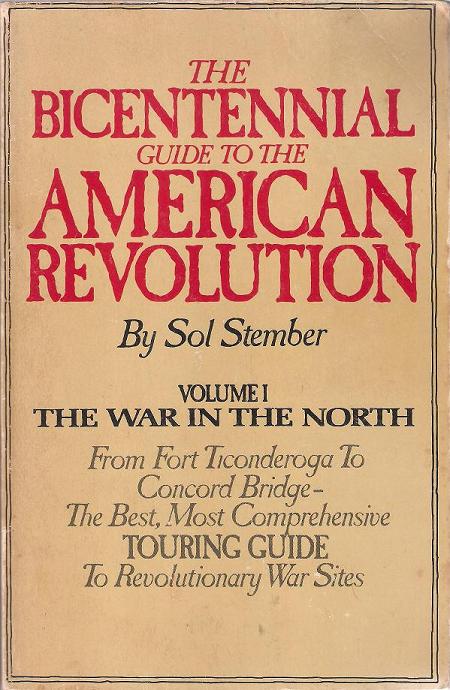
68.82 KB
Compiled and published in 1974 immediately prior to the Bicentennial of the American Revolution, Sol Stember's guidebook covers both Revolutionary and earlier colonial sites such as these, offering the proverbial wealth of information. This is the first ( and largest ) of eventually 3 volumes divided by region; I have found them indespensible in my travels! Their only drawback lies in their age: their VERY specific directions must now be read through over a quarter-century of "progress" and "development" in both the landscape and transportation network.
Image Insert:
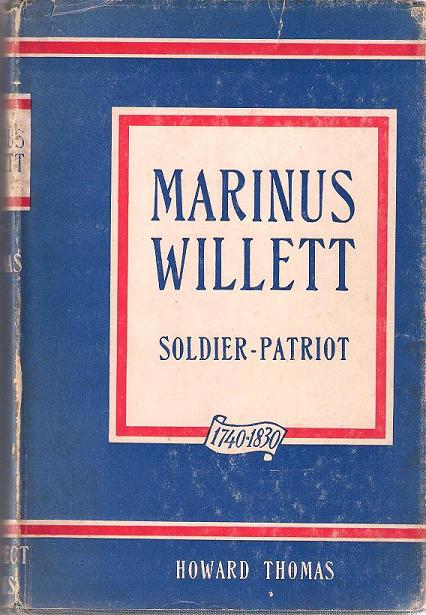
57.49 KB
Another source are items of local history and biography such as this one of Revolutionary leader Col. Marinus Willett published in a "Limited First Edition" in 1954, which I was lucky enough to find in a Dallas Half-Price Books store! It has good regional maps of the period and has a LOT of information on the war in the Mohawk Valley. Willett helped lead the revolutionaries in New York City in 1775, served as second-in-command at Fort Stanwix in 1777, commanded the troops here around Schoharie and German Flats, and served a term as Mayor of New York in the Federalist period. |
| Wilderness Woman |
Posted - January 07 2012 : 11:11:08 AM
James, I don't know what that stone building/house is. It is most likely a farmhouse that was built after the Revolutionary War or into the early 1800s, judging by its style. I have seen many of those throughout New York.
If you are referring to the 1743 Palatine House that was the parsonage for Rev. Sommers, this is it:
Schoharie Parsonage
This will probably come as no surprise to you, but I have been to the places you posted in the Schoharie Valley, as well. Most of my Palatine families went to the Schoharie after they were "released" from the failed tar-making project in the Hudson Valley. When the land disputes with the Dutch people who were already there arose, most of them moved north to the Mohawk Valley in 1725. The great Conrad Weiser settled in Schoharie, but he moved to the Tulpehocken in Pennsylvania instead of the Mohawk. |
| James N. |
Posted - January 07 2012 : 10:45:54 AM
Thank you so much, WW! I KNEW there was a good reason I'd photographed the church and its grounds, but failed to note what or where it is on the back of the print.
Since posting this, I "discovered" a few other photos I'd taken in the valley of Schoharie Creek which is a south-to-north flowing tributary on the south side of the Mohawk River and nearer to Albany. Several pertaining to the Old Stone Fort have been added to the post above; here are the rest:
Image Insert:
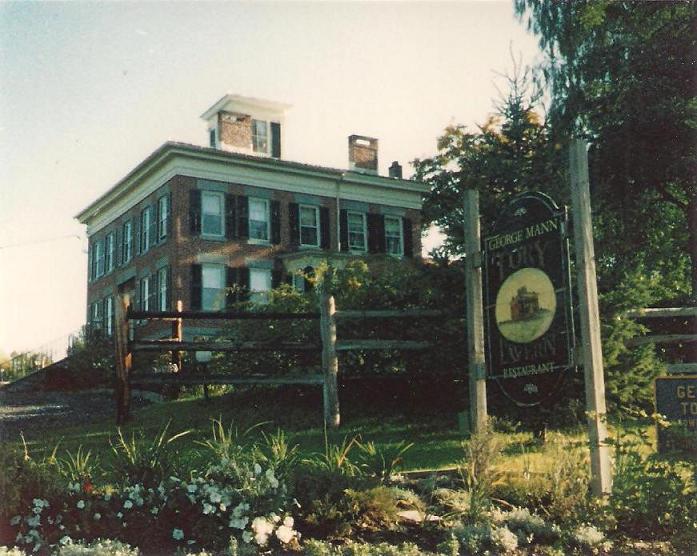
76 KB
Image Insert:
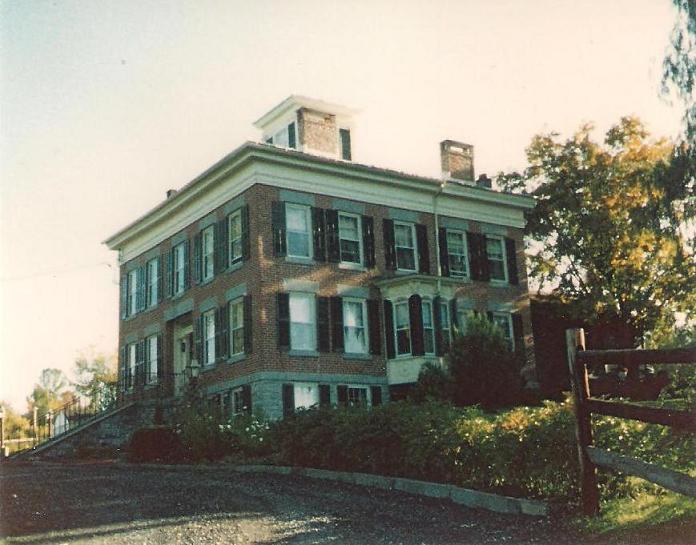
63.34 KB
George Mann's Tory Tavern is identified as a Revolutionary-period bulding known then as "the Brick House at the Forks in the Road"; supposedly the porch and cupola are later additions. Despite this identification, this structure looks far more Federal ( post-Revolutionary ) to me, unless it's been considerably renovated, always a possibility in this particular region and vintage structure. I CAN however attest to its being a restaraunt at the time of my visit because I ate here! ( I remember nothing about its quality, though; nor do I have any information about the meaning inferred by its name. )
Image Insert:
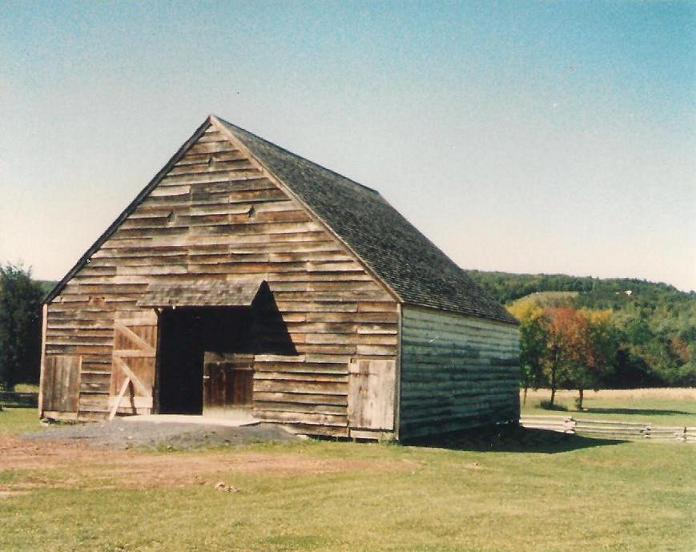
59.19 KB
Located near the Old Stone Fort Museum, this barn is improbably identified as period and also an unlikely survivor of Johnson's raid. Probably NOT the exterior, but the interior framing timbers are unquestionably OLD.
Alright, Wilderness Woman! Here's another from this area I can't identify! I THINK this may be the Parsonage of the stone church/fort from its description in my guidebook, but I'm not sure; again I made no notation on my print!
Image Insert:
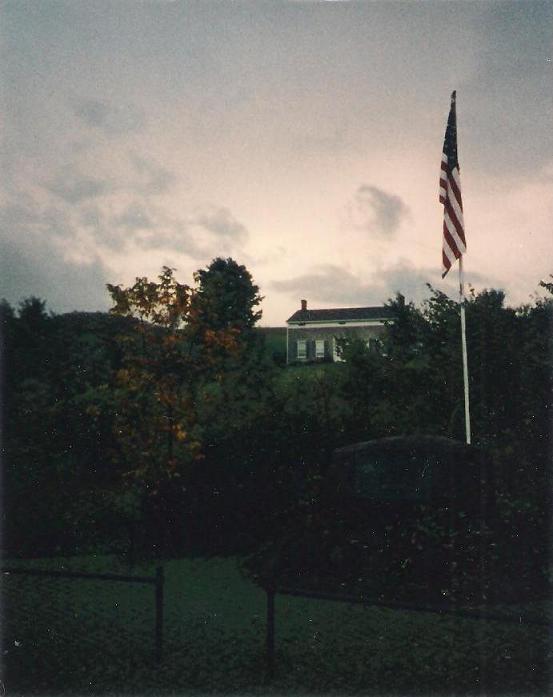
41.46 KB
|
| Wilderness Woman |
Posted - January 06 2012 : 8:53:53 PM
Well, you are really talking my language now, James! My Palatine ancestors settled in the Mohawk Valley, knew Sir William, and fought (and died) at Oriskany with General Herkimer. I have wandered all over that valley and have visited all of the places you posted photos of several times. The Oriskany Battlefield is like a shrine to me.
The "charming Colonial-period church" whose name and location you have forgotten is the Fort Herkimer Church, located on the bank of the Mohawk River south of the village of Herkimer. The first floor of the structure was built by General Nicholas Herkimer's father in the 1750s. Johan Jost Herkimer and his wife Catharina (Nicholas' parents) are both buried in the cemetery there.
Fort Herkimer Church
I have attended an Independence Day Church Service there, and there will be another one on July 1, 2012. It's a gorgeous old church that still has the old wooden box pews and the elevated pulpit. It also still has the loopholes that are visible on the exterior. |
| Monadnock Guide |
Posted - January 06 2012 : 3:35:01 PM
Some great pictures and info there James, - thanks. |
| James N. |
Posted - January 06 2012 : 3:32:11 PM
Following the twin failures of St. Leger and Burgoyne the Mohawk Valley briefly reverted to peace, which was frequently shattered in the following years as the Iroquois, often led by Brant, and Tories led by Sir William's legitimate son and heir, Sir John Johnson, and Sir William's son-in-law, the notorious Walter Butler, continued raids, attempting to regain the lands they'd lost. Often they were opposed by Col. Marinus Willett, who had been given his comission to defend the valley personally by General Washington. Despite some successes by Willett, he was unable to prevent depredations such as the Cherry Valley Massacre.
Image Insert:
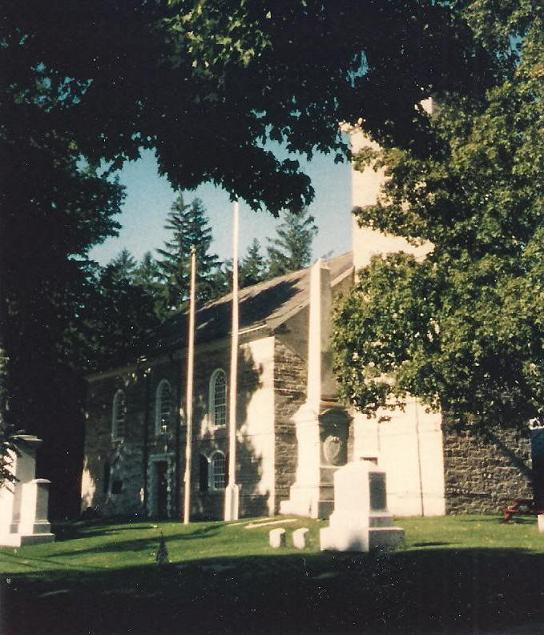
72.42KB
Another settlement raided by Johnson's Tories and Brant's Indians was in the nearby Schoharie Valley; the Old Stone Fort Museum here was built in 1772 as a church, but served as the center of an improvised fort surrounded by a stockade in which some 200 settlers successfully sheltered while about 1500 raiders plundered and burned nearby homes in October, 1780. From the bell tower legendary marksman Timothy Murphy ( best known for shooting British General Simon Fraser at Saratoga ) fired on flags of truce sent out by his commander to prevent a surrender and presumed slaughter a'la Fort William Henry!
Image Insert:
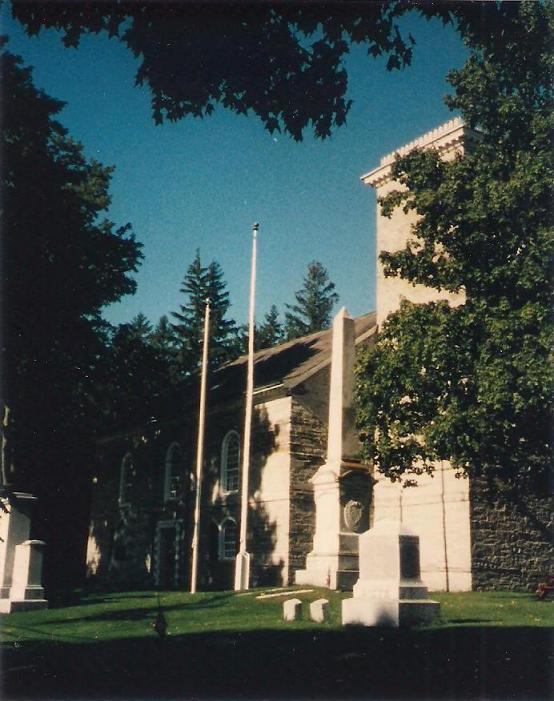
67.3KB
One of the items on display inside is what is reputed to be "the oldest fire engine in the United States", dating to about 1790 from its construction, and obviously is a pumper, with handles on both sides of its "box":
Image Insert:
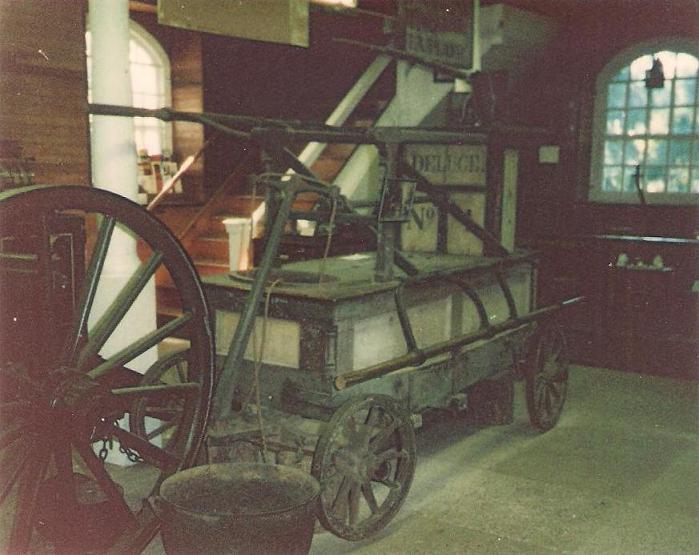
60.37KB
Outside the entrance to the church/museum is an impressive monument marking the grave of David Williams, one of the three militiamen reknowned as the captors of British spy Major John Andre during the episode of Arnold's Treason!
Image Insert:
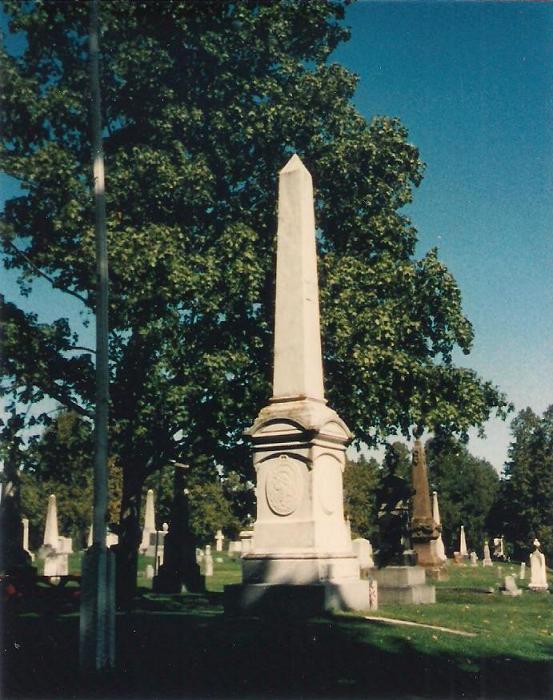
77.25KB
Unfortunately, I made NO record of what or where this charming colonial-period church and its cemetery are, but I know they're somewhere in this area too; after a space nearing a score of years, I've forgotten. If anyone recognizes them, please let me know!
Image Insert:
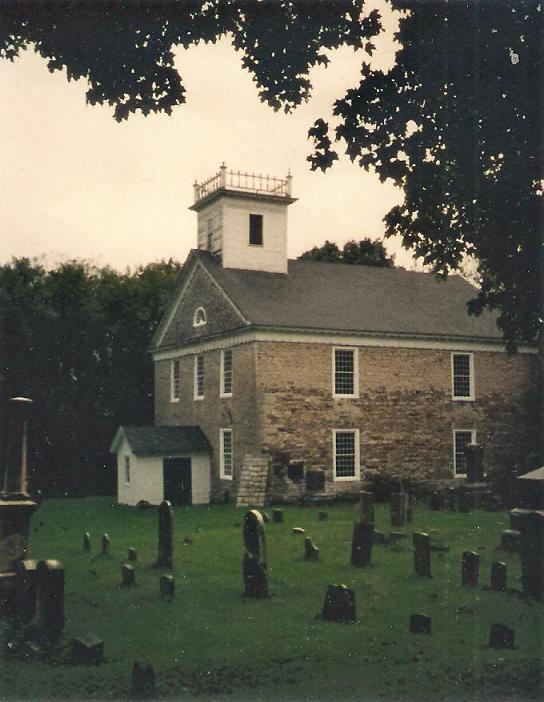
60.38KB
|
| James N. |
Posted - January 06 2012 : 2:55:52 PM
Thanks, Lane!
To continue this topic,
The defeated militia retreated back the way they'd come, to their settlement, German Flats, where Nicholas Herkimer's home and nearby grave are also maintained as state historic sites. The house is another substantial brick structure, no doubt intended as both home and "fort". Here in this house, following an unsuccessful amputation of his leg, wounded at Oriskany, Herkimer died ten days later, gripping his family Bible and surrounded by his followers. His grave is also marked by an obelisk, smaller than the one at the site of his wounding.
Image Insert:
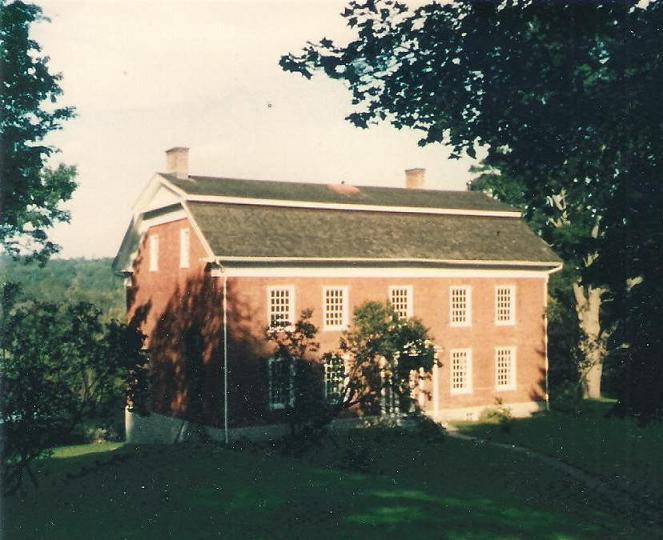
63 KB
Image Insert:
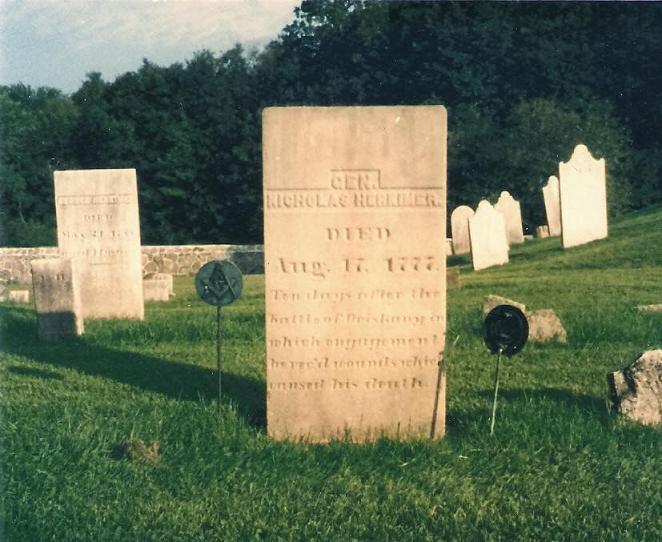
63.05 KB
Image Insert:
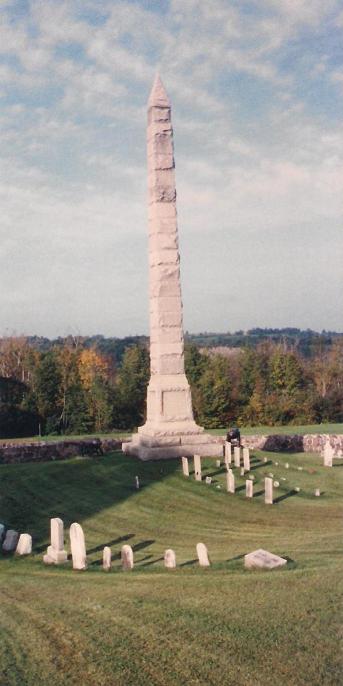
35.65 KB |
| lane batot |
Posted - January 06 2012 : 2:12:40 PM
Wow! I've read a LOT about William Johnson, and seen paintings of his home and estate, but it's great to see actual photos--thanks James! I read where some believe if it wasn't for William Johnson swaying most of the Iroquois League to side with the British, we'd be a French speaking nation right now! Which means I'd be illiterate--no way could I ever learn to conjugate all them dern !@#$%^&*()(*&^%$#@! french verbz! |
| James N. |
Posted - January 06 2012 : 2:02:57 PM
My main objective in this trip was to see Ft. Stanwix ( called Ft. Schuyler during the Revolution ), reconstructed for the Bicentennial of the siege in 1977 and now a unit of the National Park Service. Unfortunately, the day of my visit was overcast and drizzling and I found NO decent vantage points from which to photograph it; substiantially, it resembles the Fort William Henry reconstruction. One of the better features of its reconstruction undoubtedly was as an urban-renewal tear-down of the existing slum that had grown up on the original site, now in downtown Rome, N.Y.
Image Insert:
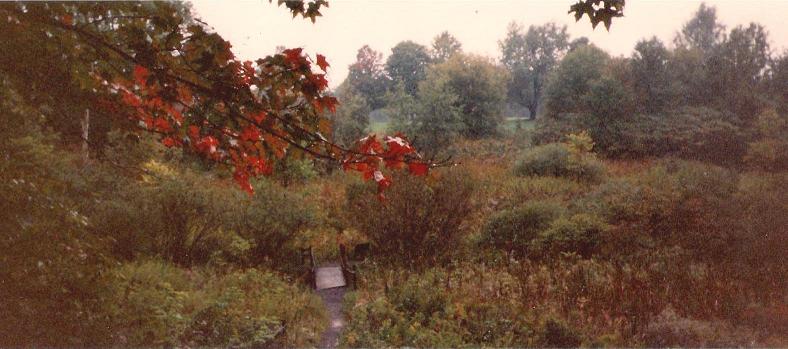
56.2KB
Oriskany Battlefield - The ravine where the colonials were first attacked.
I had better luck at nearby Oriskany Battlefield State Park, scene of an ambush by Chief Joseph Brant's Seneca and other Iroquois, allies of Barry St. Leger's British and Tories besieging Ft. Stanwix/Schuyler. The colonial militia that marched to relieve the fort were strung out in column reminiscent of Braddock's men in 1755. Fortunately, they were led by a stout Palatine German general of militia, Nicholas Herkimer, and did not panic. They continued to advance to high ground across the narrow creek and formed a rough circle from which they fought off Brant's Indians, with the wounded Herkimer propped against a saddle and puffing stoicly on his pipe while he directed the defense. Though defeated, suffering heavy losses and forced to retreat, Herkimer's force was not destroyed.
Oriskany proved to be an ironic turning point in the siege, Burgoyne's Saratoga campaign, and the entire Revolution when Continental Col. Marinus Willett led a sortie from the besieged fort during the battle that captured, looted, and burned the Indian's encampments while they were busy fighting Herkimer. The Seneca were so devastated that they gave up and returned home, leaving St. Leger too few men to continue the siege, thus foiling one prong of the British advance on Albany and allowing the Revolutionary army to concentrate their forces against Burgoyne. His surrender led to French intervention that secured American Independence: "For the want of a nail..."!
Image Insert:
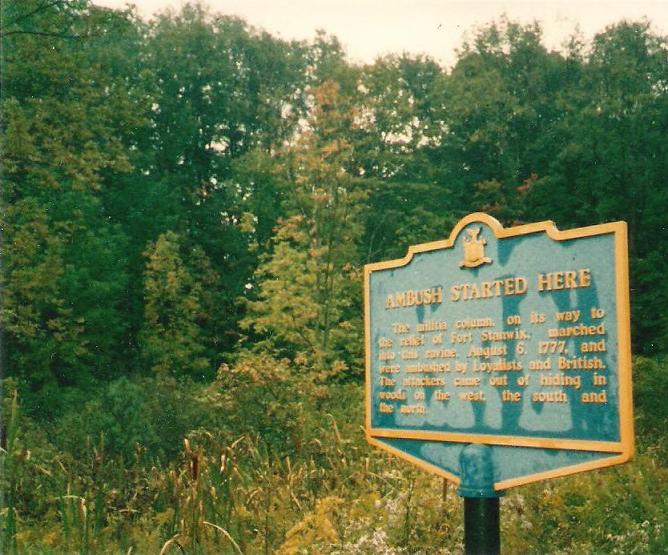
82.55KB
Image Insert:
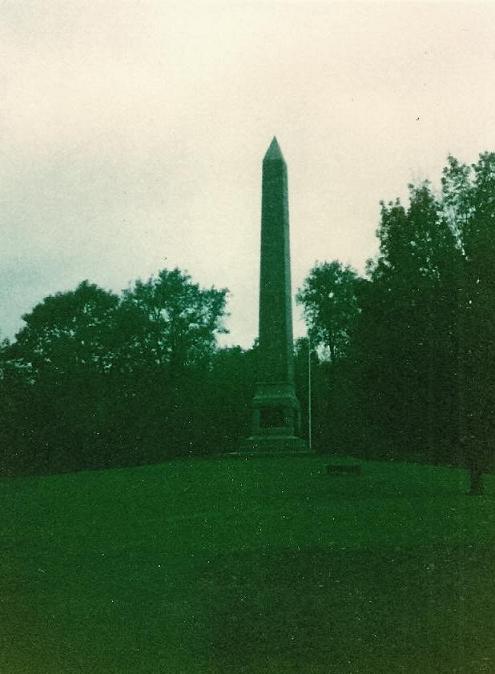
41.97KB
Unfortunately, in the late 1800's when Oriskany was acquired by the state, the fashion was to commemorate and memorialize history rather than trying to PRESERVE it; hence the focus was to scour the hilltop where Herkimer made his stand, stripping it of brush and rock and building a big obelisk on the site! The tiny museum/visitor center near its base was closed for the ridiculously short "season" ( probably no real loss there! ), but despite the drizzle I was able to hike down into the overgrown ravine where the battle had begun, affording a much better idea of the conditions under which the battle had been fought. |
|

![The Mohican Board! [Bumppo's Redux!] The Mohican Board! [Bumppo's Redux!]](images/wwwboard.gif)



